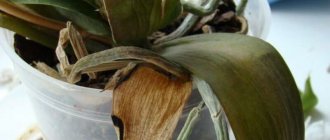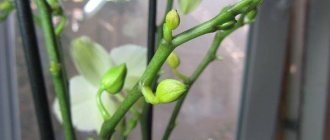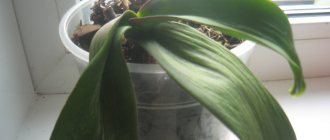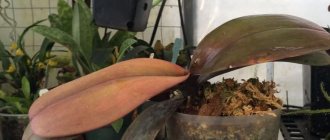If the orchid leaves have lost their turgor and are wrinkled, first of all you need to look for the cause in improper care. When considering the options for why an orchid's leaves wither, you need to check the conditions of its maintenance, the regime of watering and fertilization. Before saving an orchid, inspect its root system, since the flower may not feel well due to root disease.
To determine what to do with phalaenopsis, you need to study the conditions in which it is kept: room temperature, soil quality. The method of resuscitation will depend on the cause of the disease.
Causes of soft orchid leaves
Most often, the reason why an orchid withers is a lack of nutrition in the ground part. The lower leaves wither first. If the roots do not have time to replenish the supply of liquid and nutrients, then the lower part of the orchid gives up its reserves to the upper part.
Many problems are solved after transplanting a flower. Attention is paid to the roots of the phalaenopsis, the damaged ones are cut off. They are able to recover even if up to 95% of the roots have died.
Wilting in orchids begins with the lower leaves.
Orchid turgor can be restored by changing the regime of watering and spraying the plant. If the situation has not changed, then the reason must be sought in the temperature regime: move the pot to a warmer or, conversely, cooler place. If a plant dries out in a pot, you need to think about the quality of the soil and its density. The substrate must be loose and porous.
During the period of active growth and after flowering, the orchid needs fertilizer, but there should not be a lot of it - this will immediately affect the condition of the roots and shoots.
Why do phalaenopsis leaves turn yellow after transplantation?
The process of transplanting into another container is very stressful for the plant. A completely natural reaction to stress is a weakening of the plant, a decrease in its immunity, so the painful state of the flower after the procedure should not scare you; this is rather the rule than the exception.
Did you know? Orchids of the Kinabalu Gold variety are the most expensive flowers of their family on the planet. The plant comes from Malaysia, is quite rare and blooms for the first time only in the 15th year of life, due to which the cost of its shoots reaches up to 5 thousand US dollars per piece.
There may be several reasons for yellowing of leaves after replanting: the stress itself received during the move, adaptation to a new place of residence, change of substrate, microtraumas received during replanting (even experienced gardeners rarely manage to avoid them). Your task is to create the most comfortable conditions for the plant so that it can safely survive stress and adapt to its new place of residence.
It is best to replant an orchid in the spring, at a time when the flower is full of vitality and energy. The procedure should not be carried out during the flowering period - this may lead to the dropping of flowers. Transplantation at this time is allowed only if the life of the flower is threatened.
In order for the transplant procedure to be as painless as possible, the following rules must be followed:
- After the procedure, place the flower in a shaded room for 1–2 weeks. Select a location in advance and do not change it for the specified time. The most suitable option is a window facing east.
- Observe the temperature regime (+21…+23°C).
- The plant should be watered for the first time 5 days after transplantation, and again after 2 weeks.
The comfortable conditions you create will help the plant cope with stress and adapt faster. Usually this time is enough for all microdamages caused by transplantation to heal.
Did you know? At the turn of the 20th and 21st centuries. The annual revenue of orchid wholesalers was about 100 million US dollars, with 3/4 of this amount coming from phalaenopsis.
Insufficient watering
Insufficient watering is the most common reason why an orchid has limp leaves. If the substrate in the pot is dry, then the roots have nowhere to get moisture and they cannot nourish the shoot.
If the leaves have become soft and wrinkled, you can quickly return them to shape by normalizing watering. To do this, special attention is paid to the root system. Pots for orchids are specially made transparent so that you can see whether the root system has dried out. There should always be condensation on the inner walls of the pot. The watering interval depends on several factors: lighting, room temperature, and looseness of the substrate.
After a few days of proper watering, the leaves regain their elasticity. If the process is slow, a solution of succinic acid is used. The leaves and trunk are washed with it, and the root system is immersed in the solution for several hours. For active growth and flowering, you can spray the entire plant with succinic acid 2 times a month. The optimal temperature of the succinic acid solution is 30-40°C.
A glucose solution will help revive the flower. To prepare syrup 4 tsp. sugar is dissolved in a glass of water. Every evening the solution is applied to the outside of the leaf and washed off the next morning. This prevents excessive moisture loss. The course lasts 4 days, then take a break and, if necessary, repeat the course again.
Watering with sugar water restores the orchid.
Since sugar is a breeding ground for sooty fungus, it is important to rinse off the solution well.
Drafts and cold
There is no need to place orchids on a windowsill or next to a window where the window will open during the cold season. In winter, check if there is a draft from the window and if the pot is cold?
You will be interested to know: Folk remedies for treating late blight of tomatoes, potatoes, cucumbers
The low temperature of the substrate in which the flower grows can cause yellow leaves. After some time, the roots of Phalaenopsis will begin to rot and the leaves will fall off. Therefore, if it is cold on the windowsill in winter, place a flower pot in the room.
If the roots are still rotten, carry out the same procedure as when overmoistening the soil.
Excessive watering
If your orchid's leaves are wilting, it may be overwatering. In this case, the phalaenopsis withers completely: the roots rot, and healthy ones become insufficient to provide nutrition to the entire plant.
The plant can be cured; this will require a number of measures:
- Remove the plant from the substrate.
- Inspect each root and remove rotten tissue to healthy tissue.
- Treat the sections with charcoal, cinnamon or fungicide powder.
- Leave the roots to dry for 10 hours.
- Prepare a new dry, loose substrate.
- Replant the plant.
The plant needs to be watered when the roots have acquired a bluish-gray tint. If they are bright green, then they have enough moisture to nourish the flower. If the leaves wrinkle, the orchid is left without watering for several days.
Treatment methods
If the roots of the orchid have dried thoroughly, there is no need to immediately throw the plant away (the chances of saving it are still high). Resuscitation includes a classic set of actions, which begins with a transplant:
- The first stage consists of carefully removing the orchid from the old pot. The process is complicated by the fact that the root system grows into the drain holes and can also dry out to the walls, making it impossible to remove the flower without damage. That is why it is recommended to plant orchids in transparent plastic pots, which can be easily cut with scissors if necessary. When the plexus can be removed, try to straighten the underground part and remove the remnants of the substrate. It is also important that under natural conditions, orchid roots need access to air and light.
- Assess the extent of damage. Often, upon detailed examination, it turns out that under the accumulation of dry fragments, the orchid has completely healthy roots. The main indicator of their condition is color. A pronounced gray or silver tint is a sign of moisture deficiency. However, such parts can still be reanimated, so there is no point in cutting them off. It’s another matter if the root has acquired a brown or yellow color - in this case it cannot be saved; pruning is indicated.
If it is difficult to visually determine the condition of the root, you can lightly crush it with your hands. A viable specimen will at least partially retain its elasticity, while a dead one will crumble.
- Mark the wrinkled, dry roots with a marker. They have already given up all the nutrients to the greens and cannot be restored.
- Remove any dry roots found and sanitize the cut areas. For this purpose, powdered activated carbon or special bactericidal preparations for indoor plants (Fitosporin-M, ecogel Agricola, systemic fungicide Fundazol and other compounds) are suitable.
- Immerse the ground part in warm water and let it stand in it for a little over an hour.
- Place the orchid in a clean pot with new soil and discard the old one. It is prohibited to reuse the substrate, because a harmful substance (amines and other decomposition products) has accumulated in it.
After transplanting, you do not need to immediately start watering. By default, renewed soil contains a small supply of moisture. In addition, the treated plant should dry out a little. Therefore, watering is resumed after 1 week.
At first, sad things may happen to the orchid at first glance - the aerial root system will dry out. In reality, this indicates that the process of restoration of the main underground part has begun, and the associated withering is a natural reaction to the presence of fragments, the need for which has ceased. Depending on the severity of the damage, the period of complete rehabilitation of the orchid will take from 2 weeks to six months.
If all the roots of a plant had to be cut off, then planting in the ground is contraindicated until strong 6-centimeter roots appear. In this case, the orchid is first fixed on damp moss, and when the situation allows, it is transferred to a permanent place.
Additional recharge
A minor drying process can be stopped using conservative methods. Special fertilizers will help solve the problem. This is an effective way to save the roots located inside the pot, which are difficult to reach mechanically. To care for an orchid, ready-made liquid fertilizers specially designed for this plant variety (Agricola, Forte, Rea Sil, Royal Mix and other brands) are suitable.
You can prepare effective formulations yourself. To do this, just take a teaspoon of honey, glucose and sugar, and then dilute them in 1 liter of settled water. This watering will provide the orchid roots with the nutrients they need in a stressful situation.
After pruning the underground part of the flower, the growth regulator Epin gives good results. It is enough to dilute one drop of the drug in 1 liter of water and pour it over the plant. The action of the components is aimed at stimulating root growth, so the recovery of the orchid will accelerate.
Growth stimulants (store-bought and homemade) are used no more than once every 2 months. Otherwise, excessive growth of the root system will begin, its thinning, and as an extreme case, the orchid will begin to rot.
Manipulations to soften water
If the reason that the orchid is drying up lies in the use of bad water for irrigation, the following trick will help to revive it. Pour a small pinch of oxalic acid into a five-liter bottle and add water. After a day, the solution is filtered and watered.
You can remove excess hardness from water using wood ash or peat. One 10-liter bucket requires 30 and 100 g of components. In the resulting composition you need to soak the flaccid and dry flower (its underground part). It should remain in it for 1.5-2 hours. After this, let the orchid dry completely. The procedure must be repeated until the damage is completely restored.
If you don’t have time to do the manipulations recommended above, and there are no signs that the plant needs to be urgently saved, it is enough to use purified water for watering. To do this, it is passed through a regular kitchen filter and allowed to stand at room temperature for a day.
Hypothermia
The orchid is a tropical plant, it is sensitive to the temperature in the room. Keeping a plant in a draft or at sub-zero temperatures causes the leaves to wrinkle, their elasticity to decrease, and they gradually lose all moisture and droop.
In winter, do not place a pot with a plant on the windowsill if the temperature outside reaches -15°C. Completely frostbitten leaves are not treated; they are cut off to avoid the formation of rot and its spread to healthy tissue.
There is no need to replant a supercooled flower. If the orchid has soft, limp leaves, you can save them as follows:
- Inspect the root system, dead roots are removed, and the cuts are processed.
- If all the roots are frozen, you can grow them. To do this, the flower is lowered into the solution. The following are diluted in 1 liter of warm water: 1 ampoule of “Etamon”, 1 drop of “Radipharma”, 4 drops of “Cycron” or 2 drops of “Ribav-Extra”. The roots will grow in 1-2 months if you place the plant in clean water, a mixture of bark and moss, clean moss, or create a mini-greenhouse, for example, from a plastic bottle.
- Return the flower to the dry substrate.
- Provide moderate watering and fertilization.
Prevention
Prevention lies primarily in compliance with the conditions of detention . For comfortable growth, an orchid needs:
- Humidity 70-80%.
- Properly selected substrate.
- Diffused sunlight or fluorescent lamp.
- Temperature range 17-24 degrees.
- Reasonable watering. A sure sign is lightening of the roots.
- Timely replanting into new soil.
- Systematic inspection of the plant.
- Moderate feeding.
If all the rules are followed, the plant will feel great and there will be no problems with drying leaves.
An orchid is a very beautiful and capricious exotic plant that is not easy to keep indoors. To avoid problems when caring for it, read our materials about what to do if the orchid begins to dry out, or only certain parts of the plant - stem, roots, flowers, as well as what means and methods can be used to save a “sick” flower.
But, if such a situation arises, then you need to remember that the orchid, although capricious, is quite hardy - it is possible to restore the flower even in the absence of a normal root system. Therefore, you should not throw away the plant at the first signs of disease; it is much better to eliminate the problem and then enjoy the beautiful flowering of this exotic beauty.
Dense substrate
Air should always circulate between the roots of the orchid. This is a prerequisite for the flower, in addition to the moist environment in the pot. If your phalaenopsis leaves are wrinkled, the cause may be a dense substrate.
The substrate for the orchid should be loose.
The loose substrate provides ventilation for the roots, they remain healthy and do not rot, and excess moisture is easily removed. If the orchid withers, it means that these conditions are not met.
The cause of leaf wilting is eliminated by completely replacing the substrate. Properly processed, high-quality bark easily absorbs water, filtering it through its pores.
Incorrect transplant
Often, flower growers, after purchasing, rush to transplant an orchid into a new pot, and even choose a larger one. This is a big mistake. Epiphytes do not need a lot of space and substrate. You can simply hang them, and wrap the roots in moss and moisten it regularly.
After replanting in good soil and in a pot of suitable size, one leaf may turn yellow. This is called adaptation. If several Phalaenopsis leaves turn yellow or brown, inspect the roots immediately. You may need to replant the flower back into a smaller pot.
You will be interested to know: Description, photos and disease control of greenhouse cucumbers and in open ground
Overheat
The orchid does not like direct sunlight and hot radiators. If the leaves of a phalaenopsis wither, you need to check the air temperature in the room; the plant may have overheated.
In addition to the sun, heating comes from heated glass if the pot is on the windowsill. The leaves begin to actively evaporate moisture, the substrate heats up, and evaporation occurs in the pot. The roots experience a lack of moisture and cool down as the heat of the substrate is spent on evaporation.
In summer, the maximum air temperature for an orchid is 25°C. If limp leaves are found on the orchid, the pot should be moved to partial shade or another less hot place.
It is necessary to take measures to save the orchid immediately, otherwise the plant will quickly die; in a matter of days it can dry out completely; both the roots and the ground part will dry out to the same extent.
If the plant has been overheated for a short time, a period of several hours to several days will be enough for it to recover on its own. It is forbidden to spray the plant when it is under the sun's rays - this will cause the leaves to get burned. Spraying in summer is effective only in the evening.
When the plant is in the shade and the temperature of the roots and ground parts is equalized, the orchid can be wiped with a damp sponge and watered. To speed up recovery, add succinic acid or a drop of Epin to the water.
Large amount of fertilizers
Feeding an orchid should be done with caution: both a lack and an excess of feeding can lead to sagging leaves. Before using any fertilizer, you must read the instructions. It is not recommended to mix several types of fertilizers in hopes of getting the best results.
If the orchid's leaves have wrinkled, it may have been watered with a highly concentrated solution. The orchid will die if measures are not taken. If the leaves begin to fall, the substrate is watered with water without fertilizing. In a situation where nothing has changed in several days, it is necessary to change the soil or look for another reason.
Orchids are especially sensitive to phosphorus, potassium and other salts. If there is an excess of them, the leaves may turn yellow and fall off.
How to understand that an orchid is sick
To determine whether a flower is healthy, you need to pay attention to the main signs of orchid disease. And they can be like this:
- buds and flowers wither and fall;
- leaves turn yellow, lose elasticity, wrinkle;
- tubercles and swelling appear on the leaves;
- the plant becomes covered with white coating or rot.
Leaves turn yellow, lose turgor and fall off
If you notice at least one of the symptoms listed above, it’s time to take action!
Root diseases
The turgor of orchid leaves decreases due to various diseases of the root system. The most common are drying out and rot. To cure a plant, you need to cut off the affected roots, treat them, change the soil, water and fertilize the orchid.
You can tell that the problem is in the root system by its color: healthy roots should be green or have a silvery tint, they feel dense and hard to the touch. Young roots are light, gray, and turn green when wet. If they become soft and weak, hollow, slimy, brown spots, rotten or dry areas appear on them, and water flows out of them when pressed, then urgent treatment is needed. If you do not change the substrate for a long time, algae and bacteria appear on the bark, it wears off and the pores become smaller. Such roots are not able to absorb moisture and nourish the plant.
Until the root system is restored and the cuts are healed, the plant is not fertilized to avoid burns.
Step-by-step guide to restoring an orchid:
- Make sure that the flower has been provided with proper care, that it is not overdried and has not been subjected to overheating or frostbite.
- You can determine the strength of the root system by shaking the plant trunk. If the leaves of a phalaenopsis orchid wither and it wobbles in the ground, the trunk does not hold tightly, which means the roots are damaged.
- If the plant wobbles, then the problem lies in the roots. If it stands firmly, inspection of the roots is carried out in order to prevent and stop the disease at an early stage.
- Rotten, mucus-covered and dried roots are removed.
- Root sections are treated with alcohol-free antiseptics or crushed charcoal.
- Rooting is carried out with the addition of the preparations “Alirin” and “Maxim” to the water.
- If there is at least one healthy root, it is planted in a pot and provided with daily care.
- In the absence of healthy roots, they are built up.
Root rot in an orchid.
Method for growing phalaenopsis roots:
- The flower is placed above a vessel with water, the neck of the flower should be above the water at a distance of 2 cm, that is, none of the parts of the orchid should come into contact with the liquid.
- The container is transferred to a well-lit place, but not under direct sunlight.
- The leaves are wiped on both sides with a special fertilizer for orchids or sprayed with succinic acid. To activate root growth, 4 tablets of acid are diluted in 1 liter of water.
- After an air bath, the leaves are moistened with a mixture of vitamins B1, B6 and B12. 1 ampoule of each vitamin is diluted in 1 liter of water.
You can replant the orchid in the ground when the roots reach 5 cm in length, this will happen in 2-3 months.
If the root has not completely rotted, but only at the edge, and it still has a healthy beginning, then only the damaged part is cut off. The remainder of the root is still able to nourish the orchid, and healthy tissue forms over time at the cut site.
How does the problem manifest itself and what does it mean?
NOTE : Normal, healthy leaves are a deep green color. They are elastic, dense and smooth. The diseased leaf first begins to turn yellow before it dries. This can appear on a large scale all at once, or it can start with minor changes.
The leaf begins to dry from the tips, forming an unsightly, brittle crust . The color of such a leaf is either light sand or darker brown. But it also happens that the process first affects the middle of the sheet, resembling burns or stains.
Any deterioration in the appearance of the plant is in itself a bad signal. Dry leaves pose a danger primarily because a problem with a flower can affect the health of neighboring plants. Also, many people do not attach importance to the drying leaf, which means that disease or unfavorable conditions will destroy the flower - time for recovery will be lost.
The leaves of an orchid can dry out in a few hours, so you should not delay the rehabilitation of the plant.











